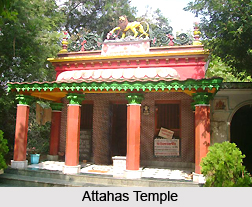 Attahas temple, also referred to as `Fullora Attahas`, is revered as one of the 51 `Shakti Peethas` located in the country of India. Shakti Peethas are the various places of India, where the different body parts and jewellery of Sati, or Goddess Shakti fell on the earth. The temple of Attahas attracts innumerable visitors every year, particularly in the month of December.
Attahas temple, also referred to as `Fullora Attahas`, is revered as one of the 51 `Shakti Peethas` located in the country of India. Shakti Peethas are the various places of India, where the different body parts and jewellery of Sati, or Goddess Shakti fell on the earth. The temple of Attahas attracts innumerable visitors every year, particularly in the month of December.
Attahas is a Sanskrit term which is derived from the words `Atta` and `Hasa` or laughter, which implies loud laughter. The temple is a significant Shakti Peetha and therefore an important place of worship of the `Shakta` sect of the religion of Hinduism. A famous mythological legend states that the lips of Sati, (the daughter of Daksha) had dropped at this very spot where this temple has been constructed. The energy or `Shakti` of this shrine is known as `Phullara` and Kalabhairava is known as `Vishvesh`.
This temple is situated in the Katwa subdivision, Bardhaman district, West Bengal and at a distance of nearly 5 km from Nirol bus stand. It is located in the Nirol gram panchayat.
This article is a stub. You can enrich by adding more information to it. Send your Write Up to content@indianetzone.com





















